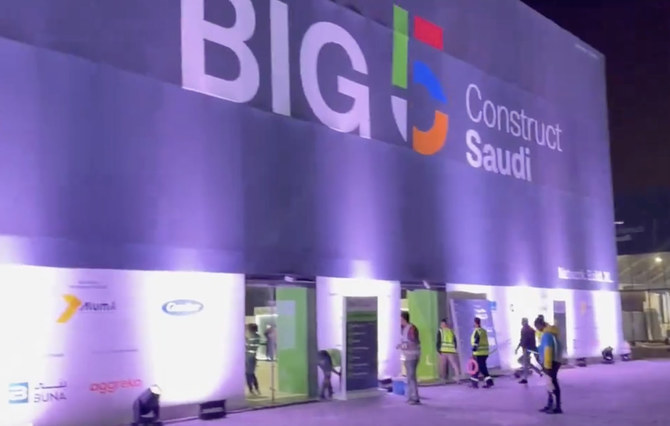Greener infrastructure solutions closer than you think in Mideast

https://arab.news/b8xq2
The year 2023 has been called the beginning of the end of the fossil fuel age, with the “UAE Consensus” agreed at COP28 calling on countries to transition away from fossil fuels to reach net zero and triple renewables and double energy efficiency by 2030 to keep 1.5°C within reach.
The Institution of Civil Engineers estimates that 70 percent of worldwide carbon emissions can be linked to infrastructure. Therefore, green infrastructure, spanning construction, water and transportation, must be at the heart of the transition.
Investment into sustainable infrastructure was a key theme at COP28, with the UK playing an important role. Prime Minister Rishi Sunak announced £1.6 billion ($2.03 billion) for international climate finance projects, including £140 million to support developing countries in achieving net zero. The commitment extends to forging new international partnerships to accelerate low-carbon steel, cement, and concrete production. Moreover, up to £80 million will be allocated through the UK Partnering for Accelerated Climate Transitions. This initiative will support governments in Africa, Asia and Latin America on their path to net zero, focusing on renewable energy projects and greener transport.
There is no one-size-fits-all solution to the challenge the wider infrastructure sector faces when it comes to reaching net zero. Each sector and subsector must act, pulling in the same direction toward our common goal.
A vision for all
Saudi Arabia has already outlined its ambitions for green infrastructure in its Vision 2030. Its flagship giga-project NEOM is set to be a country within a country, building infrastructure from optimal sustainable materials, while reaping the benefits of its location in a temperate region in northwest Saudi Arabia to create clean energy from wind and solar.
The Big 5 Construct exhibition happening in Riyadh this week is an important meeting of minds, where sustainable construction solutions will be front and center.
Building sustainably
The desert climate and elevated temperatures in the Middle East mean that buildings must be more energy-efficient and resilient to the impact of climate change. Green buildings, indeed, not only reduce the environmental impact but also contribute positively to the environment.
There is no one-size-fits-all solution to the challenge the wider infrastructure sector faces when it comes to reaching net zero.
Oliver Christian
Architecture and design companies such as Foster + Partners, Grimshaw, Cundall, and many others are deeply committed to sustainable engineering and design, making a significant contribution to the skylines of the Middle East.
Cundall’s 15 years in the Middle East have led to the successful delivery of sustainable engineering and design projects, including the Hamad International Airport and the Museum of Islamic Art in Doha. Cundall provided multi-disciplinary engineering services for Leyja, the luxury eco-tourism resort in NEOM. The company has committed to achieving zero-carbon design for 100 percent of its projects by 2030.
Foster + Partners’ projects across the Gulf Cooperation Council include the Haramain high-speed rail stations in four cities in Saudi Arabia, the Lusail Stadium in Doha, the House of Wisdom in Sharjah, the National Bank of Kuwait Tower, and the ICD Brookfield Tower in Dubai. These projects collectively demonstrate the firm’s commitment to merging cutting-edge design with sustainable practices. Notably, ICD Brookfield Place is the largest Leadership in Energy and Environmental Design, or LEED, Platinum-rated commercial building in the Middle East, incorporating artificial intelligence technology and smart sensors to reduce energy consumption by 28 percent, along with flow fittings that lower water usage by 48 percent.
In addition to the buildings themselves, the use of sustainable materials in the construction sector can have a significant impact on a project’s carbon footprint.
Innovations, such as Concrete Canvas’ low-carbon, cement-impregnated fabric that hardens on hydration, save up to 95 percent less material compared to poured, sprayed, or pre-cast concrete. This cost-effective, low-carbon solution is being utilized in slope protection projects from Saudi Arabia to Lebanon.
Concrete sand is a critically finite resource, ranking as the third most consumed natural resource globally, following air and water. The sand grains in the GCC’s desert are too round and smooth for use in concrete. UK wet processing leader CDE plays a crucial role by diverting millions of tonnes of material from landfills and developing high-quality recycled sand and aggregates. This practice helps protect sands in regions where natural reserves are in decline. With a track record of projects in over 100 countries, CDE currently has dozens of live projects across the GCC.
Water desalination technology
In the GCC countries, there is a much greater requirement for desalinated water to compensate for the absence of lakes and rivers, the lack of rainfall and limited and depleting aquifers. In fact, it’s estimated that the six GCC countries collectively produce around 40 percent of the world’s desalinated water.
However, traditional methods of water desalination are both unsustainable and expensive. This is why Desolenator’s innovative technology, using the power of the sun to produce high-quality water, presents an appealing solution. Dubai’s Electricity and Water Authority, or DEWA, selected Desolenator for its flagship plant, and the company’s second project, in partnership with Silal and ADQ, to establish the world’s first solar desalination plant for food production in the UAE.
UK companies have much to offer in the Middle East in the green infrastructure space across all disciplines.
• Oliver Christian is UK’s trade commissioner for the Middle East and Pakistan.










































